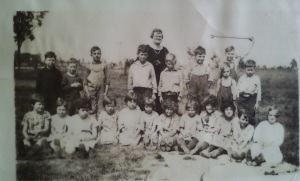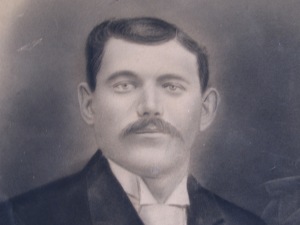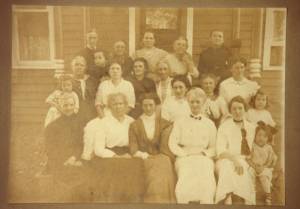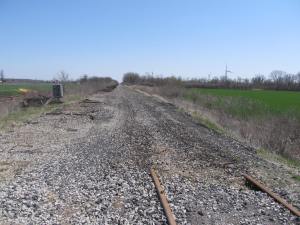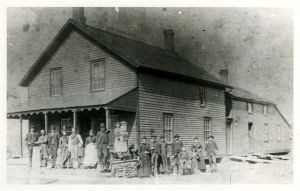Marie Valade — Daughter of the King
I am in Montreal this summer and have been thinking of a sound piece to do. I have been thinking about my connections to Quebec, which, up until a couple of years ago, I thought were non existent.
The French side of my family, The Delauriers, did not come to Canada until 1750. They moved up river very soon after arriving in Canada, first in Montreal.
What I didn’t realize is that the Delaurier men came alone. They married here, in Montreal. The families they married into were here almost from the get go.
My friend Des Coulam, in Paris, sent me this piece of writing he found about my great great grandmother many generations back. Her name was Marie Valade. I have decided to do this summer’s sound piece about Marie.
Marie Valade was born about 1649 and baptized a Protestant in the parish of Saint-Nicolas in La Rochelle. She was the eighth of nine children of freight transporter André Valade and Sarah Cousseau dite Laviolette, who were married 03 February 1630 at Saint-Nicolas de La Rochelle. Her father was the son of Antoine Valade and Ozanne Dupin from Perdry, Angoumois. Her mother, the daughter of merchant Pierre Cousseau and Huguenot Anne Bourradier or Bourodier, renounced Calvinism 27 September 1685 at Saint-Nicolas. Marie went to Canada in 1663 at about age 14, following the departure of her sister Marie, uncle Pierre Cousseau and cousin Jean Normandin and his family. She was later joined in the colony by her brothers Guillaume and Jean.
On 26 November 1663, Marie married Jean Cadieux in Montreal. Neither spouse could sign the marriage contract drawn up on 15 November by notary Basset. A plowman and locksmith, Jean was baptized 29 August 1629 in Prigné-sous-Loir (arrondissement of La Flèche, diocese of Le Mans), Maine, the son of Pierre Cadieux and Renée Fourreau or Fouvreau. He enlisted for five years with Monsieur de La Dauversière 01 May 1653 at La Flèche Montréal, where daughter Marie-Jeanne was baptized 15 October 1664, followed by Pierre (07 April 1666), Madeleine (27 October 1667) and Marie-Geneviève (21 July 1669). Jean was baptized 12 March 1671, followed by Marie (23 November 1672), Marie-Nicole (17 September 1674) and Marguerite (26 July 1676). Sadly, Marie-Nicole was buried 23 December 1677 at Montréal. Jeanne was baptized 10 July 1678, followed by Catherine on 04 March 1680. Marie-Jeanne was buried 26 June 1680.
Jean Cadieux died and was buried 30 September 1681 at Montréal. On 09 February 1682, Marie married Philippe Boudier at Montréal. Though no marriage contract has been found, it is known that Philippe could not sign his name. A farmer, he was born about 1642 in Saint-Cloud (arrondissement of Nanterre, archdiocese of Paris), Île-de-France, the son of Mathieu Boudier or Boutier (Pascal Boudier & [unknown]) and Marie-Anne Prieur, who lived in a house adjacent to the Lion d’Or Inn. The family also owned the Trois Rois Inn. Philippe and Marie lived in Montréal, where son Philippe was baptized 18 October 1682, followed by François (04 May 1684) and Françoise (30 September 1686). Sadly, son Philippe was buried 15 October 1687 at Montreal. Marie’s mother, Sara Cousseau, was buried 25 July 1691 at Saint-Nicolas de La Rochelle. Marie Valade was buried 09 January 1719 at Montréal. Philippe Boudier was buried at Montréal 24 January 1726.
Woodslee School Picture – 1925
My grandmother, being a teacher, documented the schools in Rochester pretty well. She was a teacher in South Woodslee (S.S. #15) in 1925. Madeline was formerly of Leamington. She went to Normal School in Hamilton to get her teaching certificate, then taught for a brief time at the Six Nations Reserve. Ever the traveller, she then went to Pelee Island. And then to Woodslee. When she married my grandfather, she moved to the farm and didn’t teach anymore. Her own kids went to S.S. #2, which was on the South Malden Road, a couple of miles outside of Woodslee towards Ruscomb.
This is the picture of The Junior Room at S.S. #15. The kids are:
(back row) Gordon McKenzie, Bruce Allison, Hugh Voakes, Alan Mills, Miss Madeline Delaurier, Oliver Wilcox, Kenneth Dewhirst, Stanley Roath, Harold Voakes (behind), Arthur Hunter.
Front row: Eleanor Allison, Dorothy Fair, Norma Hooker, Evelyn Roath, Alice Stothard, Violet Stowe, Mary Tweedale, Ella Holman, Eleanor Robson, Eleanor Dewhirst, Irene Voakes, Lettie Hunter
Great Grandpa Fenner – A Life
I found this online from the Comber Herald. I didn’t know my Great Grandfather. Neither did my father. My grandfather barely knew him, having only been 8 years old when his father died. I think I would have really liked him.
Death of Adam R. Fenner – Comber Herald – April 7, 1910
People of the district were pained to hear of the death of Mr. Adam. R. Fenner, Middle Road, Rochester, which occurred on Wednesday March 30, 1910 at Hotel Dieu Hospital, Windsor, following an operation for appendicitis. Death was due to blood poisoning. The deceased was well and widely known in the district. He was born on the homestead where he spent his whole life, his father being John Fenner (ed note: this is wrong … his father was also Adam. John Fenner was likely an uncle. He lived in Comber), who died some 36 years ago. He was a man of sterling worth, a progressive and industrious fellow; a man whose word was as good as his bond.
At the time of his death and for several years previous, Mr. Fenner was elected to the Council board. The ratepayers of Rochester admired the deceased for the able manner in which he assisted in conducting the township business. At all time he displayed a spirit of fairness in dealing with the many problems that so often beset the council proceedings.
The late Mr. Fenner was just entering the middle age of life, being in his 45th year, an age that is full of interest to most men when the past is full of pleasant memories and the future looking bright for the success of his family. Besides his widow, who was Miss Agnes Irwin of Mersea, eight children – four sons and four daughters – are left to mourn is unexpected departure from life. Mrs. Robert Hull, of South Woodslee, is his only sister, and Mr. William Fenner of Rochester, is a half brother. He leaves his family well provided for. Besides his land holdings of 300 acres in Rochester Township, he leaves an insurance policy of $2000 in the Maccabbees (ed. Note: a fraternal lodge based in Comber, Ontario)
The funeral took place Friday at 1:30 o’clock. The remains were conveyed to the Methodist Church, Ruscomb, where the service was conducted by the pastor, Rev. Mr. Pring, assisted by the Rev. A.B.M. Thomson of Amherstburg, formerly in charge of the circuit, and an intimate friend of the deceased. The church was too small to hold the gathering and many were compelled to remain outside during the service. After the service, the remains were conveyed to Albuna Cemetery for interment, followed by a large concourse of mourning and sympathizing friends.
The Maccabbees Lodge of Comber, of which the deceased was a member, attended the funeral in a body, and six of the members acted as pallbearers.
Members of the Rochester Council and Clerk Mousseau were also in attendance.
The Women of South Woodslee
I love it when people send me articles and pictures for my blog. This one was sent to me by Ellen Allison. The Allison famuily lived in Woodslee. Bruce Allison owned Woodslee Credit Union, where we banked. And anybody who had Ethel Allison for a music teacher would never forget her. My own musical ability (not professional, but I have fun) was nurtured when I was a child .. from my grandmothers, my mother, the Ruscomb United church hymns, and in Dr. S.F. Millen School with Miss Allison.
If anybody knows the names of the women in this picture, do tell. I am guessing from the photo that it’s early 1900s. If that’s the case, my own great grandmother Sarah Jane Ellis Totten might be in the photo …
Thanks for the picture, Ellen!
My GGG Grandfather Fought for the Wrong Side!
I have been putting together the story of Jean Baptiste Delaurier and his wife Julia Hazel, my great great great grandparents.
What’s really interesting about this story is that Jean Baptiste was a prisoner of war at the beginning of the War of 1812. He was captured by the British. Meaning, he was fighting for the Americans. The record I found says he was captured at Detroit.
His wife to be, on the other hand, was the daughter of Edward Hazel, who fought for the British (both in the southern states during the American War of Independence, and then he ended up in the Amherstburg, Ontario area fighting in the War of 1812).
So, the story which seems to be emerging is that Jean Baptiste, prisoner of war, American, somehow met Julia Hazel, daughter of Edward, British soldier.
The story that I am imagining is that somehow Edward must have been impressed with young Jean Baptiste, who was probably taken over to the Canadian (technically, British) side of the river after he was captured. I can’t think how Jean Baptiste would have met Julia unless Julia’s father somehow had a hand in it. He was The Enemy, after all. And he would have been in prison. In those days, the marriage wouldn’t have happened if the parents didn’t agree. So Edward must have seen some redeeming qualities in Jean Baptiste, despite the fact that they were on opposing sides of the war.
Julia and Jean Baptiste were married in Detroit after the war was over (in 1819). They lived stateside for a few years after their marriage. So obviously the Hazels didn’t harbour a grudge against the Americans for all those rough years of war. Julia and JB’s first child, Charles was born in Detroit. Julia received a land grant in Mersea township (near Leamington), dated 1834. That’s probably when they came back to Canada.
So, what we have is an American prisoner of war who was able to obtain a nice parcel of land from his enemy, the British. By marrying a daughter of the Empire.
And they all lived happily ever after. They had lots of kids, a very large family and we’re still all doing just fine (well, my branch of this large family tree is anyway. Can’t speak for all my other thousands of cousins).
Delaurier cousins, if you have any more info about this, I’d love some more of the blanks to be filled in.
The Founding of Leamington
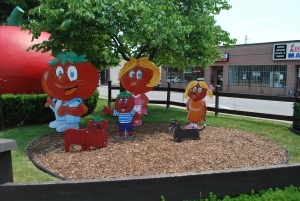
Picture: The infamous Leamington Tomato.
I haven’t revisited Earl Robson’s stories from Lake Erie Shores in a while. Here’s another one, published by my grandmother in the mid 1980s. Love Earl’s writing. I wish I had known him.
The Leamington Spa
September 6, 1951 .. The visiting mayor of our Leamington namesake will set foot in a far different place than did the first Englishmen to arrive in this Spa. The first Foster (Ralph Foster and wife Ann Wilthew) either came from the vicinity of the Royal Spa, or was familiar with the country. Among the persons dear to my memory is my Grandmother Foster, Canadian born, to whom I listened when a boy as she told fascinating tales of people and incidents in the pioneer days, when scattered log houses were set in clearings along Talbot Road East. If in her descendant’s dribble, something of a taste for aesthetics shows up, then it belongs to her lineage. Books she held sacred, from the simple fairy tale to the profound and sonorous Milton; flowers symbolized the culture that was yet to come into a crude, handmade settlement. I heard her tell of the joy expressed over the first picture to come into the drab little home. It was the frontispiece of a stray old country periodical, the first to find its way far into the gloom of the New World. A visitor in those times was met by ox-cart.
Our grandfather, John Foster, a Steadfast and purposeful farmer of pioneer times, was the Canadian born son of Ralph (and Ann), the original transplanted stock. Ralph had broken away from the established life in England, attracted by the adventure of a new world. He, like the rest of the hardy home-seekers, braved the terrors and tortures of long months aboard a wooden windjammer then the hazardous overland trail to reach the Leamington Spa, not yet born of a forest. There was no grand reception awaiting his arrival. Only brutal challenge to his strength and courage faced him.
Ralph took up a section of wooded land a mile down Talbot Road and began the titanic work of hewing out a kingdom from the wilderness. In time he became the central figure in a rugged settlement, modelled as far as he could mould it after the social strata of his native land. He became known as Squire Foster and for hears held the office of magistrate. Tradition hands down the claim, that it was he who renamed the Village of Gainesville to Leamington. The naming, I have heard from my elders, took place in the old council chambers, a a small cabin sized building located on the farm of Leonard Wigle, grandfather to Leonard and Ernest. the historical old lodge still stands on the original homestead of the first settle, Leonard Wigle, now the property of Hattie Wigle, wife of the late Forest and mother of Whitney.
Out of a dim, frowning forest of yesterdays is handed down by our grandmother a little incident of life as it once was: One when Squire Foster was burning logs back on his bush farm, two men approached him. the brawniest of the two explained he was bringing the little fellow to justice for pilfering. The plaintiff insisted the magistrate go into the village council chamber and open court. The old squire was reluctant to leave his fire, so set the culprit on a stump – the dock, and opened the case. He himself acted as counsel for the accused man, against the evidence of the plaintiff, found the stumped one guilty, and after a severe lecture and a solemn promise on the part of the wrong doer to mend his way, let him off on a suspended sentence.
Thus a thin beam of light back into the dim past! It would be enlightening to the people of England, as well as to the younger generation of Canadians, if a glimpse of raw pioneer life could be thrown on a screen. the more we pride ourselves on advancement, the more we lose sight of the fact that the grandest victory recorded in English history was the one won over monster wilderness by the brave, stout-hearted pioneers.
And for them, we honour their memories with neither holiday nor tablet!
More Info on Edward Hazel War Hero
Just got a fascinating email from Deb Honor, whose research interests include our mutual ancestor Edward “Red” Hazel, who fought in both the Revolutionary War in the United States, then was rewarded for his valiant service by being sent up by the British to fight the Americans during the War of 1812.
Deb told me previously that our mutual great great great great (x 6) grandfather fought alongside Chief Tecumseh at Moraviantown the day before he died. She now sends me this information which sheds more light on this battle and Edward’s role in it. Thanks to Deb for allowing me to share it.
The following is a letter dictated by Edward and written by someone else because it appears he couldn’t read or write. It was sent to her by Doug Robinson of Chatham — a friend of his found this in Collections Canada (National Archives) while researching an 1812 reenactment. Thanks all of you for passing it on.
Here’s the letter:
Amherstburg Upper Canada 24th March 1820
On the 5th October at the Battle of Moravian Town, I (Edward Hazel) retreated with Eighteen Men of the Regular Army, to the Long Woods about Two miles from George Wards House, the next day I returned to the Plain near Moravian Town were I was taken Prisoner by a Detachment of U.S Army who conducted me to their Main Army, the same Night I made my escape from them and took Thirty six head of Cattle with me, which I drove to George Wards House but found no person in it, I then broke open the door and went in to rest my self, after which I returned to the Indian Camp, and brought Forty Warriors to the House were I gave Ten Head of the Cattle I have taken the night before from the Americans for their support. I then took Three Indians to assist me in driving the remaining Twenty Six head to our Army.
Before I left Wards House I saw the Indians plunder it of every moveable article in the House.
The Cattle was delivered to Dept. Ajt. Commisary Genl. Reynolds + Captain Elliott of the Indian Department.
his
Edw. X Hazel
mark
So many questions — both Deb and I and a whole bunch of people are wondering how he managed to escape quietly while rounding up all those cattle. Any further comments appreciated, Deb, and thanks for passing this on.
More about The Fenner Family dynamic
A Bit More about the Fenner family dynamic..
Posted on July 19, 2013 by Victoria Fenner
I was just down to Essex County a couple of weeks ago. I did some more exploring for my documentary. Mostly about life during the time period 1850 to 1870. I’m getting more of a sense of what life was like in the middle of the county even though this time period is not well documented. Lots of reading between the lines still needs to be done.
One of the significant things I learned (or more accurately, realized) has been in front of my nose for the last year. One of the people who has me mystified is my great great grandma Fenner’s eldest son, William Henry Fenner, who was her son, but not my great great grandfather’s son. It is acknowledged in family records and in my great Grandfather’s obituary that they were half brothers. Even though records clearly show that my great great grandparents (Mary Elizabeth Dietrich and Adam Fenner) were married at the time.
I’ve posted about this before but just so nobody has to refer back to a previous post … Mary Elizabeth and Adam were married prior to 1858. I know this from Mary Elizabeth’s medical records because she had been hospitalized for most of 40 years and the medical records are quite comprehensive. William Henry’s birth records are vague but through obituaries, census etc, it would appear that he was born in 1862.
What I have always found compelling is that Great Great Grandpa raised William Henry along with the family. He was acknowledged as part of the family. This seems to be contrary to what we know about Victorian Canada .. specifically, that a woman who has a child with a man who she is not married to was scorned, branded as a loose woman and was deemed an outcast of society. And presumably, the families of such loose women would also be deemed social outcasts.
There is some vagueness about William Henry’s birth in the census etc .. the most notable being that he was born in Germany. I believe this to be not true for various reasons I’ve gone into in previous posts.)
What I like about this story is that it doesn’t follow the usual script we are told — that children born “out of wedlock” were all social outcasts, and the families associated with them are stigmatized. It is good to see that all of the children managed to marry into established families, so despite their compromised circumstances, they were not stigmatized to the extent that I would have thought. (Especially since Great Great Grandma Fenner was in a mental hospital for most of the last 60 years of her life. Everybody would have known it and yet we don’t appear to have been stigmatized and sent packing to the margins of society. And the fact that I grew up in this same small village with a lot of the original families and nobody ever breathed a word of this. And small towns have long memories …)
The surprising thing which I discovered and referred to in the lead paragraph — my great great grandfather’s will contained a proviso that a part of the farm he was buying was to be left to William Helliweg Dietrich. (the deal was in progress when his will was drawn up, so the conclusion is not clear in the will). I have wondered, ever since I found the will, who William Helliweg Dietrich was. I assumed he must have been a brother of Adam’s wife (whose last name was Dietrich). No way to prove this, but I now believe that William Helliweg Dietrich was William Henry Fenner. This seems to make sense, considering that my great great grandfather never acknowledged William Henry as his son so it makes sense he would not give him his last name in the will. Even though William Henry and his siblings all called him Fenner.
I had another look at the land records for the family farm and see that William Helliweg Dietrich did take possession of the west 50 acres of the farm which my grandfather had been successful in purchasing. That parcel of land was eventually sold to our next door neighbours, so it didn’t stay in the family as the original farm has.
The reason why I am so happy with this new piece of information is that it supports the idea that my great great grandfather was a very decent man. With my great great grandmother’s mental illness, it was a lot to deal with, especially in the latter half of the 1800s. I still think it is remarkable that he raised William Henry with his own children, and went a step further by leaving him an equal piece of land to my great grandfather’s. When all was said and done, he treated William Henry, his son by another man, almost as an equal with his own children. (Except for the name … it appears clear that great great grandpa did not let everyone believe William Henry was his. That is interesting in itself .. it would have been much easier for him just to pretend).
I have a whole pack of cousins out there who are descendents of William Henry Fenner. I feel bad writing about this is in a way, since there is now a missing branch on their family tree. They’ll likely never know who their great great grandfather was, because their father was not a Fenner as they thought. It’s all a mystery … but obviously our ancestors wanted William Henry in spirit, even if they all didn’t agree he should be a Fenner in name.
The Trains are Gone
I took a drive down old Hwy 98 this weekend through the old home village. I drove down the sideroad beside our old place next to the Ruscom River and very slowly approached the barely marked railway crossing that ran behind our place, carefully looking both ways for a train as I’d always done.
I need not have been so cautious. Because the trains are gone.
I had no idea. Last year when I visited the ancestral homeland, I never saw a train. But I assumed they were still running. Maybe they weren’t. The impact of the realization that they were gone hit me .. well .. like a freight train. I can’t explain why it was such a shock, except maybe to say that it triggered a whole set of memories. Trains in the night. The rumble of an approaching train, and then feeling it gradually get closer as it shook the house and demanded our attention with its loud whistle.
I sometimes felt a bit afraid as the train got closer. There were some very dramatic accidents that happened at those crossings, both behind our place and my grandparents. And there were some fun stories too. My father still tells about the Mail Flyers and the Wolverines and the other names they would have for the trains that came by. My mom used to take the train home from school in Ridgetown. One time, she tells me, she brought two baby goats home on the train. When I was a kid in the 1960s, the rail line was double tracked. There were no passengers trains but lots of freight. You could sometimes see two trains coming at each other on different tracks from different directions. There were a lot of trains.
This summer, I want to walk the rail line all the way from South Woodslee, through Ruscomb, to Comber. A long slow way to experience my birthplace at a leisurely pace and maybe experience the place from a different perspective. I’ll look at the surrounding land, imagining what it must have been like to be riding on one of those trains, whistle blowing, pistons pumping, flying along on the hard, flat countryside. I’ve never seen the place from the perspective of the rail line before. It would have been a little dangerous to do that a few years ago.
But now, I can walk along the rail line without having to listen for that distant rumble. I won’t have to get off the rail line. Because now, there are no trains …. just the silence of the fields. And my memories.
Looking for the Cotters of Woodslee
I have been corresponding with Dennis Cotter of Woodslee who has been trying to track down some long lost relatives.
The above picture, is the Great Southern Hotel in Woodslee — Writes Dennis — “This hotel was owned by my great grand parents Ed and Margaret Cotter, Edward (Ned) died in 1892 and Margaret ran it until she sold it to her nephew Simon Hogan in 1896. The lady on the far left is Emma Cotter Maier, one of Edward’s younger sisters.”
He is also trying to track down some missing branches of the family tree.
“My Cotter’s were from Ontario, I think near Tilbury. My grandfather, John Peck was supposedly adopted by Charles & Mary Ann Pique from around Chatham Tilbury district. I think now that there was no adoption that far back. My grand father was born in 1866 in Canada. All he knew was his real parents name was Cotter & they were too poor to keep him. Probably had other children too.
I’m wondering if there is any way to trace them. I have written to Chatham, Toronto and Ottawa and none could help. I’m glad to know two things, the name and the area. These Piques’ took him when he was a baby. My grandfather and mother’s name should have been Cotter if he wasn’t adopted.”
If anyone has any information to contribute, post a comment on this post and I’ll put you in touch with Dennis.
And thanks, Dennis, for sending me this request. I like it when people add to the knowledge that has already been collected by my grandmother. It means that our heritage and history is constantly growing. And therefore, the past, and our ancestors, still live on.
